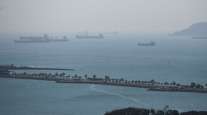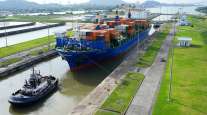Staff Reporter
With Strong Traffic, Panama Canal Bonds Get Upgrade

The Panama Canal is doing so well, it got its credit rating upgraded by Moody’s Investors Service.
The credit-rating agency upgraded the 20-year $450 million bonds issued by the Panama Canal Authority to A1 from A2, with a stable outlook. The canal has had strong performance since its lock expansion’s mid-2016 kickoff, according to a news release from the Panama Canal Authority.
The expansion added a new lane of traffic allowing for a larger number of ships and double the capacity.
The Moody’s report said overall tonnage increased, which attracted new markets, contributing to the waterway’s strong performance. The tonnage has provided solid cash flow while canal debt remains low, Moody’s reported.

A tug guides a Neopanamax cargo ship through the Agua Clara locks. (Panama Canal Authority)
In August 2018, Fitch Ratings affirmed the canal authority’s A investment grade rating with a stable outlook. In July 2018, Standard & Poor’s Global Ratings improved the canal’s outlook from stable to positive, and also affirmed its A- rating of the waterway.
In its analysis, Moody’s said increasing tonnage — freight, natural gas, petroleum and more — was a positive financial factor.
“Over the period 2007 to 2016, tonnage crossing through the canal showed a relatively flat compound annual growth rate of 1%,” wrote Adrian Garza, Moody’s senior analyst. “After the expansion, and for 2017 fiscal year (October 2016-September 2017), container tonnage increased by 22% over the same period of the previous year. For fiscal 2018, volumes continued with a positive trend, growing 9.6%.”
The improved outlook comes almost three years after the Panama Canal expanded, finishing in June 2016.
The expansion, which cost more than $5 billion, involved construction of a new set of locks on the Atlantic and Pacific sides of the waterway, creating a third lane of traffic for more cargo, especially from East Asia headed to the East Coast.
The canal now accepts ships carrying liquefied natural gas, something that had not been possible in the past, according to Robert West, an independent maritime consultant who helped the Panama Canal Authority study demand before the multiyear construction.
The first LNG-carrying ship passed through on July 25, 2016, according to the canal’s website.
“One of the questions you ask on projects like this is, ‘Is there going to be demand?’ ” West told Transport Topics.
West and canal officials soon concluded there would be, as demand and trade grew into the 21st century. And just after the turn of the century, ship builders made clear they would manufacture bigger ships even if they could not get through the existing Panama Canal. The canal was faced with a choice: Expand or lose traffic.
“We take measures to accommodate all our customers. With our resources available, we were able to program 12 transits in one day.” - #PanamaCanal Administrator @jorgelquijano #PanamaMaritimeConference pic.twitter.com/5Ig9gHWu9R — Panama Canal (@thepanamacanal) March 18, 2019
At the time, the canal could only handle the Panamax container model, which could hold up to 4,500 of 20-foot-equivalent units or TEUs, West said. Now, the canal can pass Neopanamax container ships, some with as many as 14,000 TEUs.
Since June 2016, the canal has seen more than 5,700 transits of the larger Neopanamax vessels, with a current record of 12 Neopanamax vessels transiting in a single day in February 2019, canal authority officials told TT. Four LNG vessels passed through in a single day in October.
The increased capacity gives shippers, retailers, manufacturers and truckers more logistics and supply-chain options. East Coast ports had planned for more freight after the expansion.
The canal authority reported 51% of Neopanamax vessels had been from the container segment. Liquefied petroleum gas vessels constituted 26%, while LNG carriers made up 10%. Dry and liquid bulk carriers, car carriers and cruise ships make up the remaining transits, the canal authority said.
The Panama Canal Authority said 62.8% of the total cargo transiting the canal has its origin or destination in the United States.
Additionally, the Panama Canal announced that it formally joined the Global Industry Alliance, a public-private partnership initiative of the International Maritime Organization, which is working to improve energy efficiency and reduce greenhouse gas emissions in international shipping.
The alliance launched in June 2017.




